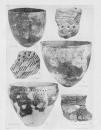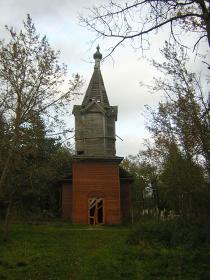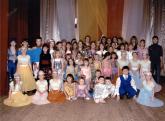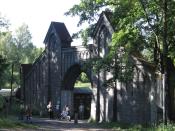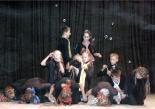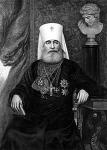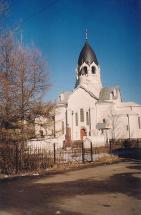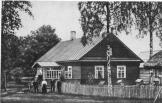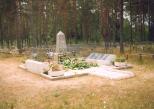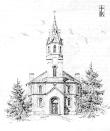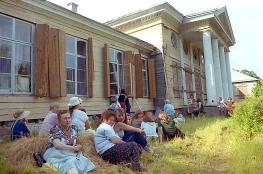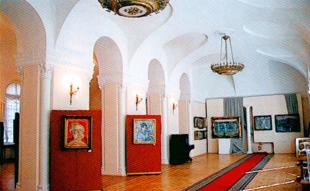|
hidden
|
E.F. Kankrin, monument to
reference
|
|
|
hidden
|
Eagle Column, the
The town of Gatchina.
|
|
|
hidden
|
Early Metal Epoch, the
The early Metal Epoch. In 2000 BC ancestors of the Finno-Ugric tribes, which include the local Neolithic population, mooved to the Leningrad Oblast territory from Verkhneye Povolzhye (the Volga River upperstream region). They brought the culture of... more
|
|
|
|
hidden
|
"Eccentric", a theatre
reference
|
|
|
hidden
|
"Echo of War", a memorial
reference
|
|
|
hidden
|
Edinoverie
Edinoverie (E.), union of the Old Belivers with the Russian Orthodox Church (ROC) on the basis of the hierarchy obedience of the Old Belivers to ROC with preservation of the Old Belivers order of services and ceremonies which were formed... more
|
|
|
|
hidden
|
Efimovsky House of Culture
reference
|
|
|
hidden
|
"Elfs", children variety-music theatre-studio
“EL’FY” (“ELFS”), children’s variety and musical theatre-studio (20, Lenin st., Vyborg Town). It was founded in July 2003 on the Leningrad Oblast Governor’s order on the base of aesthetic education classes at town comprehensive school N 8. Students... more
|
|
|
|
hidden
|
Elizavetino, a country estate
reference
|
|
|
hidden
|
Engel, Karl (1778 - 1840), an architect
Engel, Karl Lyudvigovich (Karl Ludvig) (1778 - 1840), an architect, town-planner. He was originated from Germany. He graduated from the Academy of Architecture in Berlin. Engel worked in Abo (Turku) and Helsingfors (Helsinki). From 1825 he was in... more
|
|
|
|
hidden
|
Enso*, v. Svetogorsk, town
reference
|
|
|
hidden
|
"Entrée", a theatre
“ANTRE” (“ENTREZ”), drama theatre (10, Lenina av., Lodeynoye Pole Town). It was founded in 1995 on the base of theatre department at Lodeynoye Pole Town Centre of Children’s Aesthetic Development (CCAD). Founder and creative director is A.A.... more
|
|
|
|
hidden
|
Eparchy of Saint Petersburg
Eparchy of Saint Petersburg , territorial-administrative unit of ROC (Russian Orthodox Church). It was established according to the order of Empress Elizabeth Petrovna on 1 September 1742, before it was territorially included into the Novgorod... more
|
|
|
|
hidden
|
Eparhy of Vyborg and Finland
The Eparchy of Vyborg and Finland. In 1809 Finland was included into the Russian Empire. There were about twenty five thousand members of the Orthodox Church (the majority of members was in the Ladoga rigion) in sixteen parishes of Finland in... more
|
|
|
hidden
|
Eparhy of Korelia
Eparchy of Korelia (Korelian and Oreshsky/Oreshkovsky Eparchy; according to other names - Korelian and Koporsky). It was founded in 1595 after Tyavzinsky Treaty of Peace with Sweden when the town of Korela (now the town of Priozersk) was given back... more
|
|
|
hidden
|
Eparhy of Novgorod
Eparhy of Novgorod. It is one of the oldest eparchies in Russia (it has been being since 992). The eparchy was the largest, it included five administrative regions (pyatinas) as well as the Pskov, Onega Lake, Karelia lands and the region of the... more
|
|
|
|
hidden
|
Eparhy of Olonets and Kargopol
The Eparchy of Olonets and Kargopol. Othodox monasteries and churches of the Olonets region (the territories of present-day Korelia, partly of the Vologda and Leningrad Regions) were originally included into the Eparchy of Novgorod. The foundation... more
|
|
|
hidden
|
Ermilovo House of Culture
reference
|
|
|
hidden
|
"Ernane Ma", holiday
reference
|
|
|
hidden
|
Eskuzovich, Ivan Vasilyevich (1882 - 1942), an architect
Eskuzovich, Ivan Vasilyevich (1882 - 1942), an architect, engineer, theatre painter. He graduated from the Institute of Civil Engineers in 1909. Eskuzovich participated in building dwelling houses in St. Petersburg. After the Revolution of 1917 he... more
|
|
|
|
hidden
|
Especially restricted natural areas
The especially restricted natural areas. These areas of land, water surface and airspace which have the natural complexes and objects. These areas have special environmental, scientific, cultural, aesthetic, recreational and curative value. These... more
|
|
|
hidden
|
Estonians
Estonians (their native name is Eestlased, old use - Maarakhvas) is an ethnic community. The Estonian language is related to the Baltic-Finnic subgroup od the Finno-Ugric branch of the Uralic language family. They live in Estonia (963 thousand... more
|
|
|
|
hidden
|
"Eternal Love of Native Land", festival
reference
|
|
|
hidden
|
Ethnic deportations
Ethnic deportations are forced resettlement carried out according to an ethnic signs. In 1935-36 in the Leningrad Oblast there were some activities on purging the zone of land with 22 kilometres wide at the border with Finland "from kulak and... more
|
|
|
|
hidden
|
Ethnic groups if the Leningrad Oblast
Ethnic communities of the Leningrad Oblast. The settled communities of people historically formed on the certain territory, having the common features of culture and self-consciousness expressed in the native name are called an ethnic community (or... more
|
|
|
|
hidden
|
"Evangelical Chistianity", see Baptism
reference
|
|
|
hidden
|
Evangelical-Lutheran Church of Ingria
Evangelical-Lutheran Church of Ingria (ЕLC of Ingeia). Oganizing of ЕLC of Ingria began when Russia surrendered the South shore of the Gulf of Finland and the Karelian Isthmus to Sweden according to the Treaty of Stolbovo in 1617... more
|
|
|
|
hidden
|
"Evenings in Monrepo", a chamber classical music festival
“VECHERA V MONREPO ” (“EVENINGS IN MONREPO”), festival of chamber classical music. It has been held since 1992 on the initiative of the State History, Architecture and Nature Museum-Reserve “Park Monrepo” (“Monrepo Park”) with the assistance of... more
|
|
|
|
hidden
|
Exhibition Hall "Smolny"
reference
|
|
|
hidden
|
Exhibition Halls
EXHIBITION HALLS. Trere is a wide network of exhibition halls, opened at the museums, Houses and Palaces of Culture, city and district libraries, in the Leningrad Oblast. Since April 1979 Exhibition Hall at Slantsi Town local history museum has... more
|
|
|



